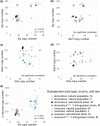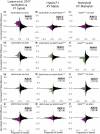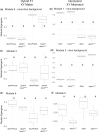The contribution of sex chromosome conflict to disrupted spermatogenesis in hybrid house mice
- PMID: 36194004
- PMCID: PMC9713461
- DOI: 10.1093/genetics/iyac151
The contribution of sex chromosome conflict to disrupted spermatogenesis in hybrid house mice
Abstract
Incompatibilities on the sex chromosomes are important in the evolution of hybrid male sterility, but the evolutionary forces underlying this phenomenon are unclear. House mice (Mus musculus) lineages have provided powerful models for understanding the genetic basis of hybrid male sterility. X chromosome-autosome interactions cause strong incompatibilities in M. musculus F1 hybrids, but variation in sterility phenotypes suggests a more complex genetic basis. In addition, XY chromosome conflict has resulted in rapid expansions of ampliconic genes with dosage-dependent expression that is essential to spermatogenesis. Here, we evaluated the contribution of XY lineage mismatch to male fertility and stage-specific gene expression in hybrid mice. We performed backcrosses between two house mouse subspecies to generate reciprocal Y-introgression strains and used these strains to test the effects of XY mismatch in hybrids. Our transcriptome analyses of sorted spermatid cells revealed widespread overexpression of the X chromosome in sterile F1 hybrids independent of Y chromosome subspecies origin. Thus, postmeiotic overexpression of the X chromosome in sterile F1 mouse hybrids is likely a downstream consequence of disrupted meiotic X-inactivation rather than XY gene copy number imbalance. Y chromosome introgression did result in subfertility phenotypes and disrupted expression of several autosomal genes in mice with an otherwise nonhybrid genomic background, suggesting that Y-linked incompatibilities contribute to reproductive barriers, but likely not as a direct consequence of XY conflict. Collectively, these findings suggest that rapid sex chromosome gene family evolution driven by genomic conflict has not resulted in strong male reproductive barriers between these subspecies of house mice.
Keywords: FACS; ampliconic genes; hybrid male sterility; intragenomic conflict; sex chromosomes; speciation; testis expression.
© The Author(s) 2022. Published by Oxford University Press on behalf of Genetics Society of America. All rights reserved. For permissions, please email: journals.permissions@oup.com.
Figures







Similar articles
-
Stage-specific disruption of X chromosome expression during spermatogenesis in sterile house mouse hybrids.G3 (Bethesda). 2022 Feb 4;12(2):jkab407. doi: 10.1093/g3journal/jkab407. G3 (Bethesda). 2022. PMID: 34864964 Free PMC article.
-
The Composite Regulatory Basis of the Large X-Effect in Mouse Speciation.Mol Biol Evol. 2017 Feb 1;34(2):282-295. doi: 10.1093/molbev/msw243. Mol Biol Evol. 2017. PMID: 27999113 Free PMC article.
-
Meiotic sex chromosome inactivation is disrupted in sterile hybrid male house mice.Genetics. 2013 Mar;193(3):819-28. doi: 10.1534/genetics.112.148635. Epub 2013 Jan 10. Genetics. 2013. PMID: 23307891 Free PMC article.
-
Hybrid sterility in the mouse.Trends Genet. 1996 Oct;12(10):412-7. doi: 10.1016/0168-9525(96)10040-8. Trends Genet. 1996. PMID: 8909138 Review.
-
Misregulation of Gene Expression and Sterility in Interspecies Hybrids: Causal Links and Alternative Hypotheses.J Mol Evol. 2016 May;82(4-5):176-82. doi: 10.1007/s00239-016-9734-z. Epub 2016 Mar 29. J Mol Evol. 2016. PMID: 27025762 Review.
Cited by
-
Different complex regulatory phenotypes underlie hybrid male sterility in divergent rodent crosses.bioRxiv [Preprint]. 2024 Nov 11:2023.10.30.564782. doi: 10.1101/2023.10.30.564782. bioRxiv. 2024. Update in: Genetics. 2025 Feb 05;229(2):iyae198. doi: 10.1093/genetics/iyae198. PMID: 37961317 Free PMC article. Updated. Preprint.
-
Different complex regulatory phenotypes underlie hybrid male sterility in divergent rodent crosses.Genetics. 2025 Feb 5;229(2):iyae198. doi: 10.1093/genetics/iyae198. Genetics. 2025. PMID: 39601270 Free PMC article.
-
Investigating DRD2 and HTR2A polymorphisms in treatment-resistant schizophrenia: a comparative analysis with other treatment-resistant mental disorders and the healthy state.Eur Arch Psychiatry Clin Neurosci. 2025 Feb 12. doi: 10.1007/s00406-025-01970-9. Online ahead of print. Eur Arch Psychiatry Clin Neurosci. 2025. PMID: 39934320
References
Publication types
MeSH terms
Grants and funding
LinkOut - more resources
Full Text Sources
Medical

